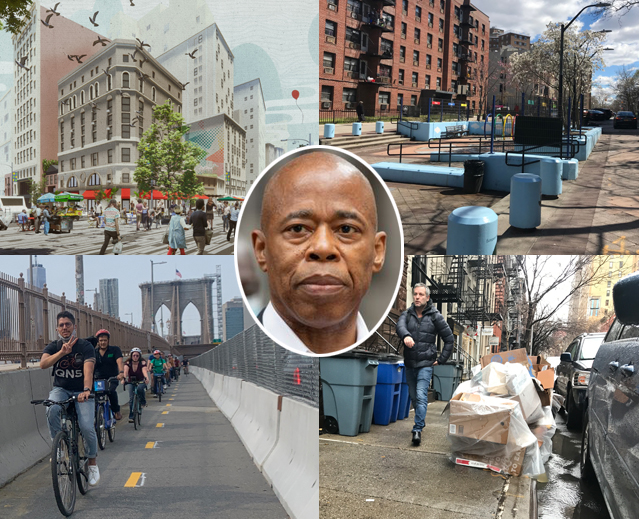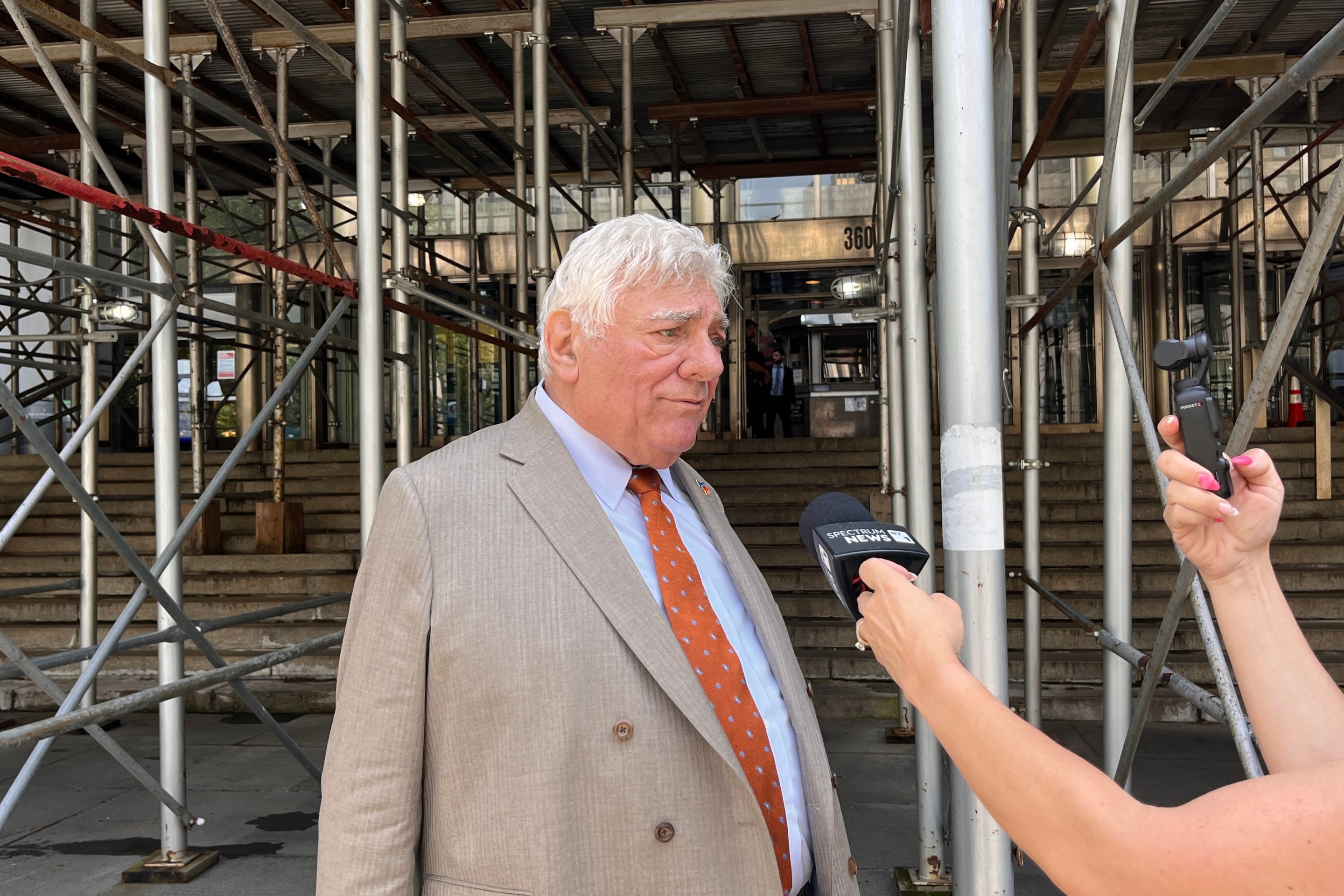Safe streets for all (not just rich neighborhoods). Faster commutes for all (including long-suffering bus riders). Dignified and respectful urban design for all (not just residents who have a well-funded business improvement district in their neighborhood).
And most of all: less space for cars.
That's at the top of the Transportation Alternatives latest policy agenda, "Seven Steps to Save Our Health, Our Safety, Our Environment, and Our Economy by Making Better Use of New York City’s Streets" (full report here), that's being released today.
“New York City’s streets must be a pathway to recovery,” Transportation Alternatives Executive Director Danny Harris said in a statement. “We are eager to partner with Mayor-elect Eric Adams to use the city’s largest publicly owned space, our streets, as a way to make New York City more resilient, equitable, and safe. From improving commutes for bus riders, to providing all New Yorkers with high-quality open space, to making cycling more accessible, a better future for our streets is possible."
The report is not really limited to seven steps, by the way, but more like 70 because each of the seven steps has 10 substeps, and it builds on Adams's own policy statement, as well as TA's earlier NYC 25X25 plan to repurpose a quarter of city street space from cars to public use. But here's the gist:
- Step 1: Convert space for cars into space for people
- Create “School Streets” by closing streets to car traffic adjacent to every New York City school (which the de Blasio administration has not even considered).
- Recapture land lost to Robert Moses-era highway projects to create open space and public transportation infrastructure.
- All sidewalks must be a minimum of eight feet wide.
- Convert an unspecified number of parking spots near every subway station with something more useful to the 99 percent of transit riders who walk or bike to their station — such as bike parking, a wider sidewalk or just a place to chill.
- Daylight every intersection — and make sure people don't park in the new vision corridors.
- Get trash out of the way of pedestrians and put it in garbage corrals or sealed bins on the street. Store dozens of residents' trash in the space of one resident's car. (By the way, the city defiantly objects when activists try to do this.)
- Create 1,000 miles of open streets.
- Create a Low-Traffic Neighborhood program like London's, which reduces speeds and also reduces cut-through traffic.
- Create at least two Barcelona-style "superblock" pilots in each borough. (Don't know what that is? Watch this incredible Streetfilms mini-documentary.)
- Turns some through streets into cul-de-sacs with a playground (like RFK once tried to do!).
- Step 2: Make our streets healthy and fair
- Change the definition of "level of service" to expand beyond cars to all road users and begin "allocating street space based on goals for mode-shift, climate resilience, and traffic-related harm reduction."
- Implement the Streets Master Plan (which is probably delayed).
- Decriminalize jaywalking, which, as Streetsblog has repeatedly documented, is enforced in a racially suspect manner.
- Develop traffic-reduction plans to improve air quality in neighborhoods with the highest asthma rates (something the Health Department has refused to do).
- Use sound monitors to make sure noise does not exceed 100 decibels. And track horn-honking among the city fleet and city taxis.
- Rewrite the Sanitation Department's annual snow removal plan so the agency no longer waits to fully clear car lanes before addressing unplowed bike lanes and corners. And get more small equipment, please.
- Plant more trees in neighborhoods that need them the most (our map is here).
- Retrofit the city's truck fleet with more cameras and mirrors so they meet "high visibility" standards.
- Do a better job of doing a better job: "Expand the data collected in the Mayor’s Management Report to include more metrics that benefit people, and not cars, such as the percentage of bike lanes painted green, bus lanes painted red, average number of days until bus and bike lane bollards are replaced, and average number of days until tree requests are fulfilled."
- Create an income graduated fine program for all parking and traffic-related offenses
- Step 3: Reduce the number of cars in New York City:
- Track car use in the city better, so we know how many New Yorkers own cars, where they go and when.
- Require city agencies to reduce the amount of driving their employees do.
- Make sure bigger cars pay more in vehicle-use fees to compensate (partly!) for the damage they do to roads, lungs and families of people killed.
- Repeal mandatory parking minimums, an effort to reduce guaranteed parking spaces that Streetsblog has covered.
- Convert 25 percent of the city's free parking into metered parking.
- Shut 'em down! Revoke the license of any business "that repeatedly illegally parks cars in the public way, such as on sidewalks, in crosswalks, or in bike lanes, a common and extremely dangerous practice."
- Set a specific goal for decreased mileage traveled by city workers in city vehicles.
- Crack down on car registration and insurance fraud, a form of reckless indifference that keeps bad drivers on the road — like the one who allegedly killed 3-month-old Apolline Mong-Guillemin in September.
- Provide free Citi Bike memberships to all city employees who don't drive to work.
- Do not allow carveouts in congestion pricing (looking at you, Mayor-elect Carveout).
- Step 4: Build self-enforcing streets
- "Require the Department of Transportation to add permanent traffic-calming infrastructure on the most dangerous residential streets."
- Put "leading pedestrian intervals" on every corner.
- Bolster protections of bus and bike lanes.
- Separate traffic enforcement from the NYPD "so that the enforcement of moving violations is separated from armed policing."
- Strengthen the Dangerous Vehicle Abatement Act to its original intent: drivers who get five automated red light camera or speed camera summonses (instead of the current five red light or 15 speeding tickets) in any 12-month period will have their cars booted if they don't take a safety refresher course.
- Increase the percentage of intersections with red-light cameras from 1 percent to 10 percent.
- Add cameras to all bus routes to ticket bus lane blockers.
- Lobby Albany to allow the city to set its own speed limit (a big push that failed earlier this year in Albany).
- Create more automated enforcement to nab more speeders and people who ignore red lights on school buses. This could include “failure to yield” cameras to protect pedestrians and “blocking the box” cameras to deter motor vehicles from clogging intersections.
- Stop opposing a City Council bill to allow residents to report illegal parking on sidewalks, in bus lanes and in bike lanes.
- Step 5: Scale the successes of Vision Zero (there are some!)
- Declare traffic violence an epidemic and a public health crisis.
- Stop letting the Department of Transportation blow off the Vision Zero Design Checklist or pretend it is making roads like Atlantic Avenue safer when it is not.
- Put speed governors on all city fleet cars.
- Retime all traffic lights to deter speeding.
- Punish repeat offenders: Suspend any city employee who kills someone in a car (until the investigation is over). And city employees who get more than five camera-issued speed- or red-light tickets in six months must be automatically suspended. The same rules should apply to drivers for companies with city contracts.
- Better enforce overweight vehicle regulations.
- Truly incentivize the cargo bike revolution.
- See number eight in the above section (yes, we caught a repeat).
- Scale up the cost of camera-issued tickets so that repeat offenders pay more than the paltry $50 fine.
- Visit the site of every fatal crash — and require the DOT to "make an engineering change at the site within one year."
- Step 6: Put bus riders first
- Create a plan for car-free bus lanes accessible within a quarter-mile of every New York City residence.
- Create a true bus rapid transit system.
- Create a "curb management strategy" that discourages truck double-parking and bike- and bus-lane blocking.
- Create car-free busways for the 10 most-used bus routes.
- Push through all bus lane projects that have already been presented to community boards.
- Create a standard for bus lane design, with set widths, paint treatments and 24-7 operation.
- Make boarding and exiting easier with bus bulbs.
- Put bus shelters and seats at every stop.
- Make mode shift from driving to transit part of the DOT's stated mission.
- Demand that the MTA add bike racks to buses.
- Step 7: Get more butts on bikes
- Create a plan for protected bike lanes accessible within a quarter-mile of every New York City residence.
- Follow national standards for bike lane width and protection, including creating protected bike intersections.
- Expand Citi Bike to every neighborhood.
- Make sure all bridges can be biked over legally and 24-7. The Verrazzano Bridge famously does not have a bike lane. The Triboro does, but it's illegal to use.
- Finish all greenway connectors to create a "a multi-borough off-street circuitous route."
- Create a massive secure bike parking program.
- Create a municipal bike and e-bike subsidy program modeled on Europe's.
- Work out a unified fare system for the MTA, NYC Ferry and Citi Bike.
- Build the Regional Plan Association's Five Borough Bikeway.
- Train a new generation of bike mechanics through a program in the Department of Small Business Services. It's a valuable trade.
The TA agenda comes out just two days before the World Day of Remembrance for the victims of road violence on Sunday. The local New York commemoration will be at Brooklyn Borough Hall at 3 p.m. Click here for info.






